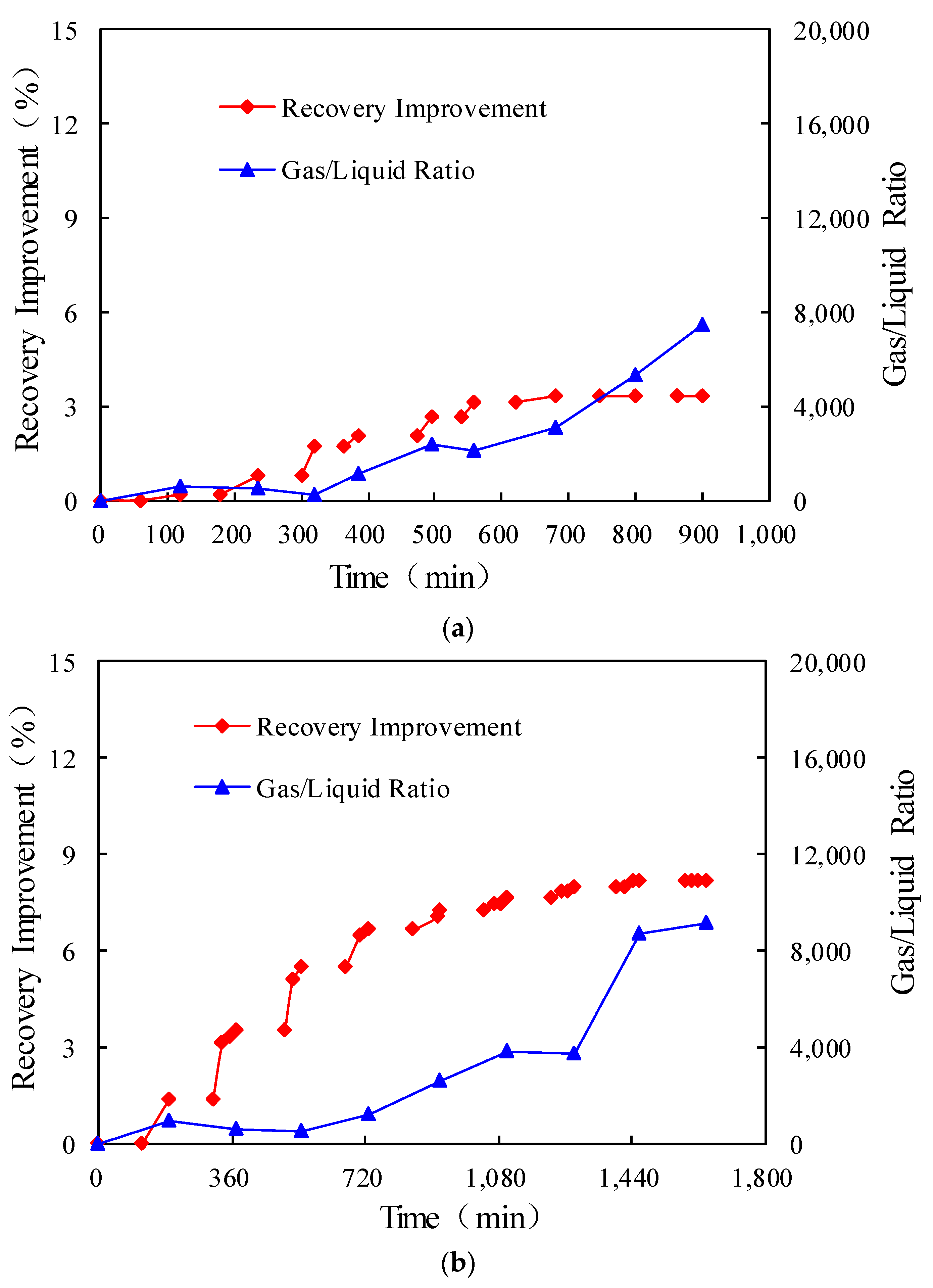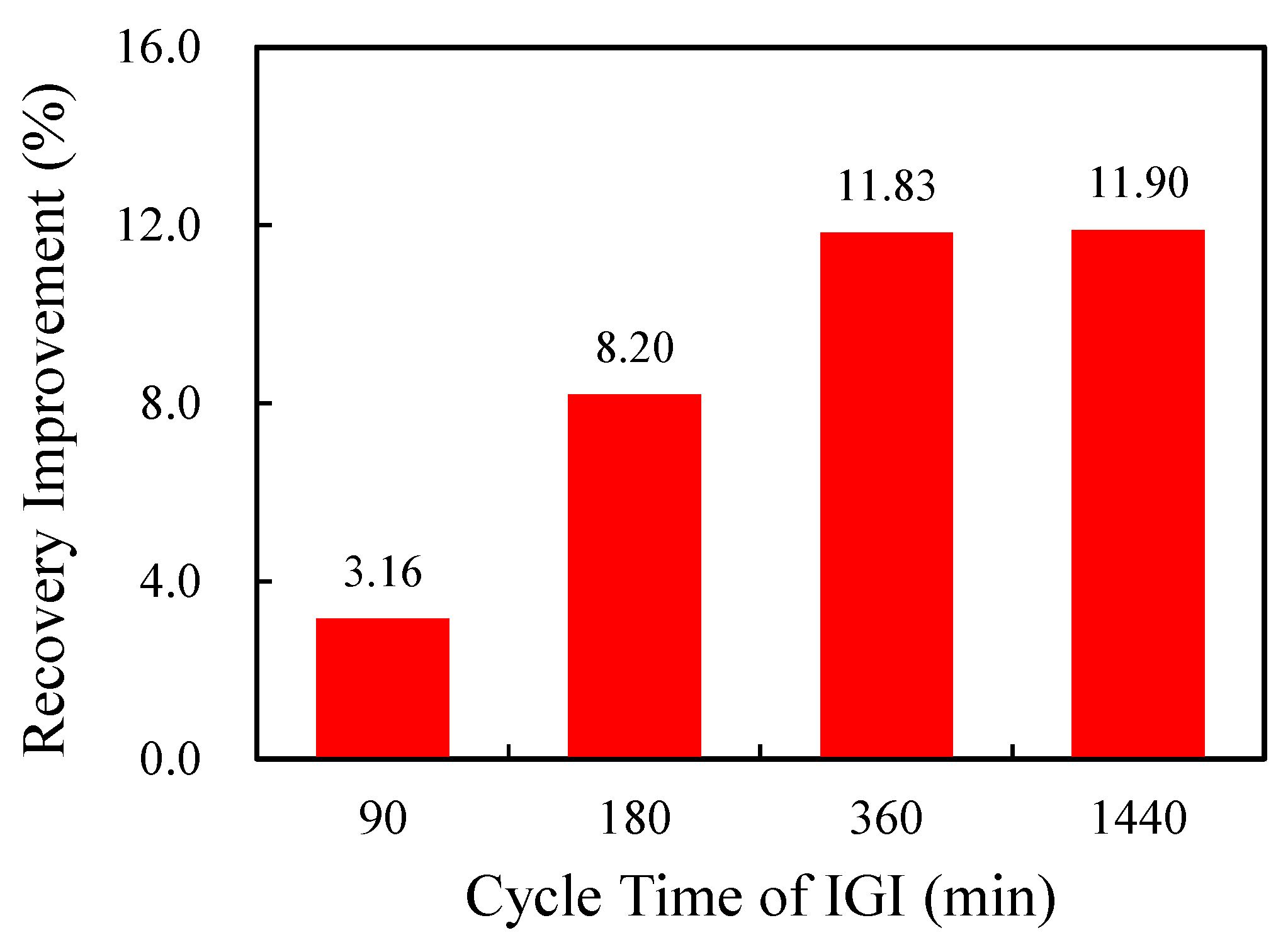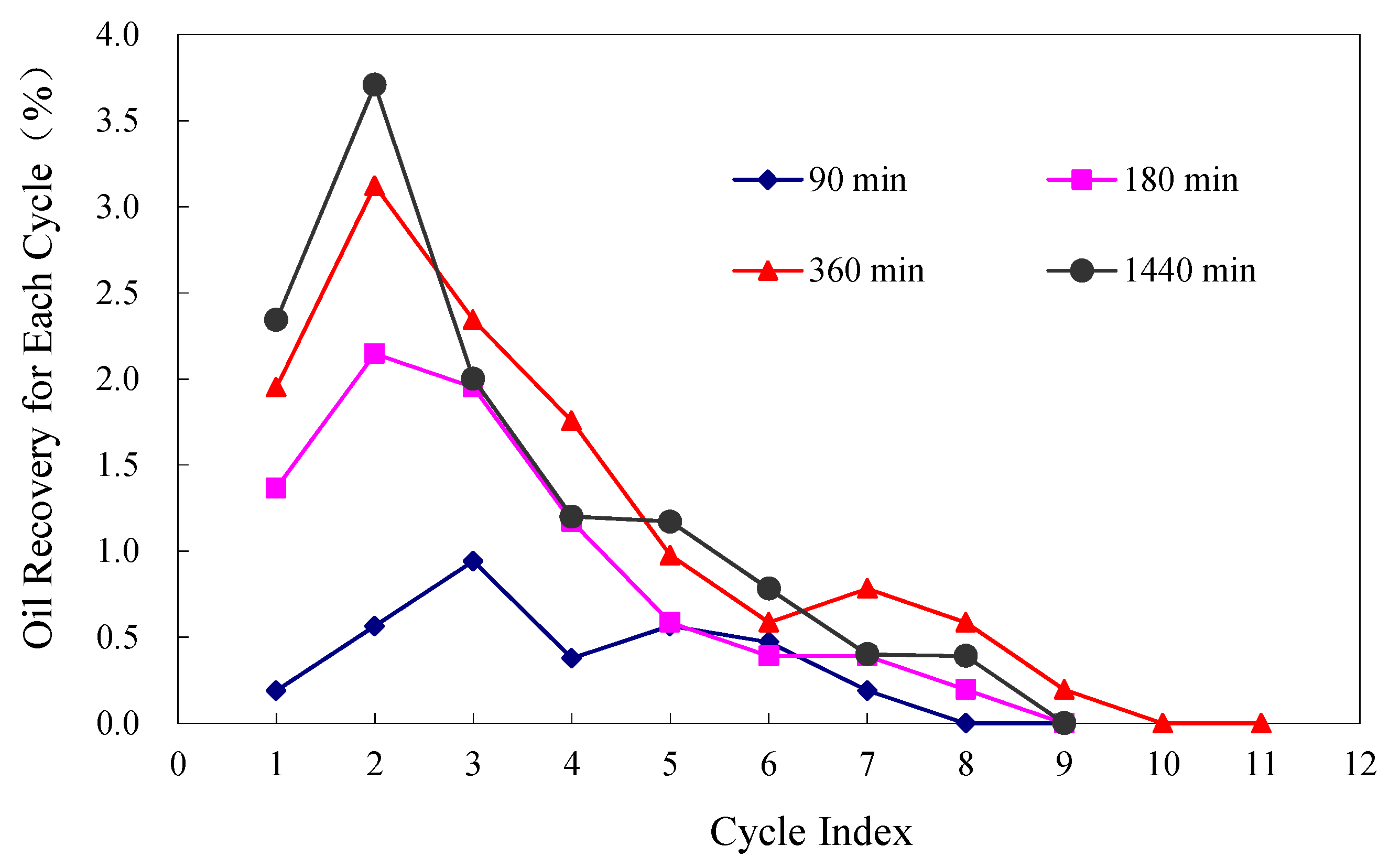Investigation on the Injection Pattern of Intermittent Natural Gas Flooding in Ultra-Low Permeability Reservoirs
Abstract
1. Introduction
2. Experiment
2.1. Experimental Devices and Materials
2.2. Experimental Processes
3. Experimental Results and Analysis
3.1. Analysis of EOR of IGI
3.2. Optimization of IGI Parameters
3.2.1. The Cycle Time of IGI
3.2.2. The Cycle Index of IGI
4. Conclusions
- Intermittent natural gas injection (IGI) has the advantage of controlling gas fingering compared with continuous natural gas flooding. It can enhance oil recovery because IGI can reduce the gas mobility and improve the swept volume effectively.
- The oil recovery is influenced by the cycle time of IGI. It improves obviously with the increase in cycle time and changes little when the cycle time reaches 360 min in the ultra-low-permeability reservoir.
- The oil recovery of IGI improves with the increase in the cycle index. The increment of oil recovery is obvious in the initial three cycles, while it changes little after five cycles in the ultra-low-permeability reservoir.
Author Contributions
Funding
Data Availability Statement
Acknowledgments
Conflicts of Interest
Correction Statement
Nomenclature
| IGI | intermittent natural gas injection |
| EOR | enhanced oil recovery |
| GOR | gas/oil ratio |
| WAGI | water-alternating gas injection |
References
- Tang, Y.; Chen, Y.; He, Y.; Yu, G.; Guo, X.; Yang, Q.; Wang, Y. An improved system for evaluating the adaptability of natural gas flooding in enhancing oil recovery considering the miscible ability. Energy 2021, 236, 121441. [Google Scholar] [CrossRef]
- Tu, X. Comparative Analysis of CO2 Miscible Flooding and Conventional Natural Gas Flooding. Contemp. Chem. Ind. 2020, 49, 956–960. [Google Scholar]
- Yue, X.A.; Wang, F.Y.; Wang, K.L. Enhanced Oil Recovery Foundation, 1st ed.; Petroleum Industry Press: Beijing, China, 2007. [Google Scholar]
- Khormali, A.; Moghadasi, R.; Kazemzadeh, Y.; Struchkov, I. Development of a new chemical solvent package for increasing the asphaltene removal performance under static and dynamic conditions. J. Pet. Sci. Eng. 2021, 206, 109066. [Google Scholar] [CrossRef]
- Khormali, A.; Sharifov, A.R.; Torba, D.I. Experimental and modeling analysis of asphaltene precipitation in the near wellbore region of oil wells. Pet. Sci. Technol. 2018, 36, 1030–1036. [Google Scholar] [CrossRef]
- Nelson, P.H. Pore-throat sizes in sandstones, tight sandstones, and shales. AAPG Bull. 2009, 93, 329–340. [Google Scholar] [CrossRef]
- Zheng, T.; Liu, X.; Yang, Z.; Luo, Y.; Zhang, Y.; Xiao, Q.; He, Y.; Zhao, X. Identification of seepage mechanisms for natural gas Huff-n-Puff and flooding processes in hydrophilic reservoirs with low and ultra-low permeabilities. J. Energy Resour. Technol. 2021, 143, 063004. [Google Scholar] [CrossRef]
- Ding, M.; Wang, Y.; Yue, X.-A.; Chen, W.; Shi, S. The effects of initial gas content of the oil on recovery by natural gas flood. Pet. Sci. Technol. 2015, 33, 1454–1462. [Google Scholar] [CrossRef]
- Ding, M.; Wang, Y.; Liu, D.; Wang, W.; Chen, W. Mutual interactions of CO2/oil and natural gas/oil systems and their effects on the EOR process. Pet. Sci. Technol. 2015, 33, 1890–1900. [Google Scholar] [CrossRef]
- Yuliang, S.; Chunxin, W.; Li, G.; Xiaodong, W. Determination of waterflooding limits for driving an ultra-Low permeability reservoir. Pet. Drill. Tech. 2012, 40, 82–86. [Google Scholar]
- Wei, H.; Yue, X.; Zhao, Y.; Li, L.; Jia, D. The injection pattern of immiscible nitrogen displacement after water flooding in an ultra-low permeability reservoir. Pet. Sci. Technol. 2013, 31, 2304–2310. [Google Scholar] [CrossRef]
- Lifei, D.; Miao, W.; Wei, W.; Hun, L. Investigation of natural gas flooding and its channelling prevention as enhanced oil recovery method. Geosystem Eng. 2021, 24, 137–144. [Google Scholar] [CrossRef]
- Fu, H.T.; Wang, S.D. Research status of gas flooding. Energy Chem. Ind. 2015, 36, 44–48. [Google Scholar]
- Sheng, J.J. Enhanced oil recovery in shale reservoirs by gas injection. J. Nat. Gas Sci. Eng. 2015, 22, 252–259. [Google Scholar] [CrossRef]
- Tang, L. Analysis on influencing factors of natural gas flooding in low permeability reservoir. World Pet. Ind. 2021, 28, 60–64. [Google Scholar]
- Haoguang, W.E.I.; Xiang, Y. An experimental investigation of the natural gas immiscible displacement in ultra-low permeability reservoirs. Acta Pet. Sin. 2011, 32, 307–310. [Google Scholar]
- Zhang, Y.Y.; Cui, H.X.; Han, H.J.; Han, B.; Li, H.J. Study on numerical simulation of enhancing oil recovery using natural gas in the low-permeability oil reservoirs. Pet. Geol. Recovery Effic. 2005, 12, 61–63. [Google Scholar]
- Guo, Y.; Yang, S.; Li, L.; Wang, G.; Zhao, W. Experiment on physical modeling of displacement oil with natural gas for long core. FaultBlock Oil Gas Field 2009, 16, 76–78. [Google Scholar]
- Haines, H.K.; Monger, T.G. A laboratory study of natural gas huff-n-puff. In CIM/SPE International Technical Meeting; OnePetro: Richardson, TX, USA, 1990; ISBN 978-1-55563-480-3. [Google Scholar]
- Phukan, R.; Gogoi, S.B.; Tiwari, P. Enhanced oil recovery by alkaline-surfactant- alternated-gas/CO2 flooding. J. Pet. Explor. Prod. Technol. 2019, 9, 247–260. [Google Scholar] [CrossRef]
- Bayat, M.; Lashkarbolooki, M.; Hezave, A.Z.; Ayatollahi, S. Investigation of gas injection flooding performance as enhanced oil recovery method. J. Nat. Gas Sci. Eng. 2016, 29, 37–45. [Google Scholar] [CrossRef]
- Heidari, P.; Alizadeh, N.; Kharrat, R.; Hossein Ghazanfari, M.; Laki, A.S. Experimental analysis of secondary gas injection strategies. Pet. Sci. Technol. 2013, 31, 797–802. [Google Scholar] [CrossRef]
- Wan, T.; Sheng, J.J. Evaluation of the EOR potential in hydraulically fractured shale oil reservoirs by cyclic gas injection. Pet. Sci. Technol. 2015, 33, 812–818. [Google Scholar] [CrossRef]
- Ahmadi, Y.; Hasanbaygi, M.; Kharrat, R. A comparison of natural depletion and different scenarios of injection in the reservoir from the beginning of oil production. Pet. Sci. Technol. 2014, 32, 2559–2565. [Google Scholar] [CrossRef]
- Kulkarni, M.M.; Rao, D.N. Experimental investigation of miscible and immiscible water-alternating-gas (WAG) process performance. J. Pet. Sci. Eng. 2005, 48, 1−20. [Google Scholar] [CrossRef]
- Farsetti, S.; Farisè, S.; Poesio, P. Experimental investigation of high viscosity oil–air intermittent flow. Exp. Therm. Fluid Sci. 2014, 57, 285–292. [Google Scholar] [CrossRef]
- Li, Y.Q. Enhanced oil recovery and application review by gas injection in low permeability oil reservoirs. Tuha Oil Gas 2004, 9, 112–116. [Google Scholar]
- Nguyen, T.A.; Ali, S.M. Effect of nitrogen on the solubility and diffusivity of carbon dioxide into oil and oil recovery by the immiscible WAG process. J. Can. Pet. Technol. 1998, 37, 24–31. [Google Scholar] [CrossRef]






| Component | Concentration/% | Component | Concentration/% |
|---|---|---|---|
| Methane | 94.08 | n-Butane | 0.168 |
| Ethane | 1.10 | CO2 | 0.532 |
| Propane | 0.326 | N2 | 2.81 |
| Number | Permeability /10−3 µm2 | Porosity /% | Cycle Time/min | Cycle Index | ||
|---|---|---|---|---|---|---|
| Injection Stage | Pause Stage | Total | ||||
| JX-1 | 6.88 | 8.75 | 60 | 30 | 90 | 11 |
| JX-2 | 8.33 | 120 | 60 | 180 | 11 | |
| JX-3 | 8.09 | 240 | 120 | 360 | 11 | |
| JX-4 | 8.39 | 1080 | 360 | 1440 | 11 | |
Publisher’s Note: MDPI stays neutral with regard to jurisdictional claims in published maps and institutional affiliations. |
© 2022 by the authors. Licensee MDPI, Basel, Switzerland. This article is an open access article distributed under the terms and conditions of the Creative Commons Attribution (CC BY) license (https://creativecommons.org/licenses/by/4.0/).
Share and Cite
Dong, L.; Li, L.; Dong, W.; Wang, M.; Chen, X. Investigation on the Injection Pattern of Intermittent Natural Gas Flooding in Ultra-Low Permeability Reservoirs. Processes 2022, 10, 2198. https://doi.org/10.3390/pr10112198
Dong L, Li L, Dong W, Wang M, Chen X. Investigation on the Injection Pattern of Intermittent Natural Gas Flooding in Ultra-Low Permeability Reservoirs. Processes. 2022; 10(11):2198. https://doi.org/10.3390/pr10112198
Chicago/Turabian StyleDong, Lifei, Linxiang Li, Wenzhuo Dong, Miao Wang, and Xiaozhi Chen. 2022. "Investigation on the Injection Pattern of Intermittent Natural Gas Flooding in Ultra-Low Permeability Reservoirs" Processes 10, no. 11: 2198. https://doi.org/10.3390/pr10112198
APA StyleDong, L., Li, L., Dong, W., Wang, M., & Chen, X. (2022). Investigation on the Injection Pattern of Intermittent Natural Gas Flooding in Ultra-Low Permeability Reservoirs. Processes, 10(11), 2198. https://doi.org/10.3390/pr10112198





